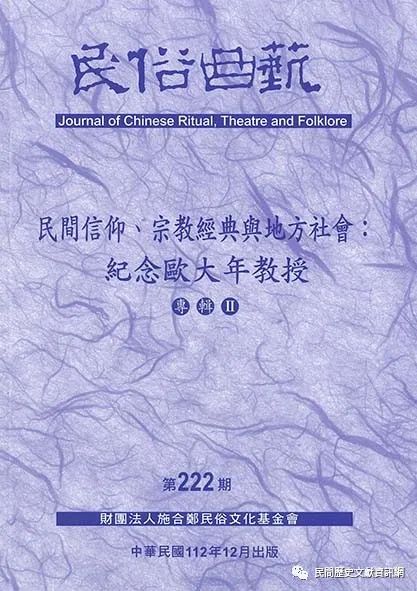
目錄
前言(趙昕毅、王見川)
【專題:研究論文】
Xucun, a Brief History / John Lagerwey
現存安龍謝土儀式資料中所見的普庵信仰探索:以「化九良」為考察線索 / 伍小劼、劉芸
「聖地」的塑造:近代青幫組織中的羅教記憶及其空間化 / 陳明華
Consuming Rice Cakes, Sailing to Salvation: The Taiwanese Longhuapai Initiation Festival and the Question of Buddhist Orientations among Zhaijiao (Vegetarian Sects) / Nikolas Broy
當代冀東南民間教派的儀式專家:以經卷為中心的研究 / 徐天基、羅丹
流動的神譜:以山西洪洞五道將軍為個案 / 王堯
性別與親密:泰山娘娘相關寶卷中的人神關係 / 馬竹君
摘要
John Lagerwey. “Xucun, a Brief History.” Journal of Chinese Ritual, Theatre and Folklore 222 (2023.12): 19-61.
勞格文。〈許村簡史〉。《民俗曲藝》222 (2023.12): 19-61。
Abstract
Xucun is a village in northern She County, Anhui (ancient Huizhou), that has been dominated by the Xu lineage since the Northern Song. This paper presents a succinct account of its history and customs focused on its chief temples, ancestor halls, and festivals. The earliest local god was the earth god; the earliest temple Buddhist. In 1292, a temple to Wang Hua was built, and in 1343 a temple to Xu Yuan and Zhang Xun. Ancestor halls were built throughout the Ming and Qing, and territorial festivals became increasingly lineage dominated. Throughout these changes, there is one constant: fengshui, particularly as expressed in the gradual construction of three successive shuikou.
伍小劼、劉芸。〈現存安龍謝土儀式中所見的普庵信仰探索:以「化九良」為考察線索〉。《民俗曲藝》222 (2023.12): 63-95。
Wu Xiaojie and Liu Yun. “An Exploration of Pu’an Beliefs in the Extant Anlong Xietu (Retaining the Dragons and Thanking Earth) Rituals: A Clue Seen in “Converting Jiuliang”.” Journal of Chinese Ritual, Theatre and Folklore 222 (2023.12): 63-95.
Abstract
中國社會的安龍謝土儀式中,不少有普庵信仰的內容。我們收集的數十冊安龍謝土儀式科儀文本中,有多處包括了誦《釋談章》、貼「普庵符」、念《普庵經》等普庵信仰的內容,如此可以退煞降福。尤其是科儀本中提及了普庵進入安龍謝土儀式的原因「化九良」,這一內容與《普庵祖師靈驗記》「降九良星異」記載相符,說明普庵「降九良」是「化九良」的原型,此點少為學者注意。發掘這一內容不僅可以明確普庵信仰的內容,同時也使我們更嚴肅地思考《普庵祖師靈驗記》與普庵信仰內容的關係。
陳明華。〈「聖地」的塑造:近代青幫組織中的羅教記憶及其空間化〉。《民俗曲藝》222 (2023.12): 97-134。
Chen Minghua. “Shaping the “Holy Land”: Memories of the Luo Sect and its Spatialization in the Development of the Modern Green Gang (Qingbang).” Journal of Chinese Ritual, Theatre and Folklore 222 (2023.12): 97-134.
Abstract
杭州北新關、拱宸橋一帶地處京杭大運河的末段區域,明末清初大量信奉羅教的糧船水手麋集於此,他們藉助羅教的儀式框架結成群體。雖然此後羅教迭遭查禁,但這套框架卻一直為水手們沿用,鑲嵌其中的羅教記憶因此得以流傳。隨著晚清社會經濟的變遷,漕運水手大量上岸,其中不乏繼續以羅教元素結成群體,其中即包括青幫的前身「安清道友會」。隨着青幫勢力在清末民初大肆發展,關於羅教的零星記憶逐漸被幫內人士加工成一套本幫起源故事。起源故事的流傳抬升了杭州在青幫敘事中的神聖地位,安清家廟、祖師墓等意象成為道統的重要象徵。抗戰時期,日本勢力出於建立統治秩序之需,試圖通過賦予合法身分整合各種「潛勢力」群體。「中國安清同盟會」等青幫團體即藉此機會公開活動並擴張組織,青幫的起源歷史和各種儀式因有助於塑造群體認同而得到當局重視,杭州也因其特殊地位而被營造成青幫的起源「聖地」。
Nikolas Broy. “Consuming Rice Cakes, Sailing to Salvation: The Taiwanese Longhuapai Initiation Festival and the Question of Buddhist Orientations among Zhaijiao (Vegetarian Sects).” Journal of Chinese Ritual, Theatre and Folklore 222 (2023.12): 135-85.
百可思。〈吞噬糍粑,駛往救世:關於臺灣龍華派過光場儀式以及齋教之佛教導向問題〉。《民俗曲藝》222 (2023.12): 135-85。
Abstract
This paper explores the seven-day initiation festival known as guoguangchang 過光場(“passing the place of light”) performed by the Taiwanese Longhuapai 龍華派(“Dragon Flower Sect”) as an intersection of not only sectarian but also Buddhist, Daoist, Confucian, and popular religious teachings, rituals, cosmological notions, moral values, cultural idioms, and material religion. Drawing on a 2010 case study of the Audience at Heaven Hall (Chaotiantang 朝天堂) in Changhua City (彰化市), as well as Qing-period source material, this paper supplements existing research in situating the festival in both the sectarian repertoire and the larger religious landscape of Chinese societies. By picking three rituals as case studies, I demonstrate the synthetic fusion of various elements that cut across established scholarly categories, such as Buddhist, Daoist, or sectarian. I look at (1) Altar arrangements that theatrically reenact cosmogenesis according to native Chinese and Daoist cosmologies; (2) The Collective salvation of neophytes in the “dharma boat” (fachuan 法船) ritual; and, (3) The ritual preparation of a rice offering, which, in its most recent variant, explicates a fusion of native and Buddhist cosmological concepts.
This paper thus seeks to contribute to the long-standing scholarly discussion of conceptualizing some religious group as “Vegetarian Sects,” zhaijiao 齋教, an umbrella term used in Taiwan to denote the Longhuapai and two other sectarian traditions. While earlier studies priorities their purportedly Buddhist orientation, including the late Danial Overmyer’s pioneering characterization of Chinese sects as “folk Buddhist religion,” I draw attention to other diverse religious elements in the Longhuapai’s initiation festival, and thereby seek to highlight the highly “synthetic” nature of its teaching and practices.
徐天基、羅丹。〈當代冀東南民間教派的儀式專家:以經卷為中心的研究〉。《民俗曲藝》222 (2023.12): 187-229。
Xu Tianji and Luo Dan. “The Ritual Experts of Contemporary Popular Religious Sects in Southeast Hebei: A Study Centered on Scriptures.” Journal of Chinese Ritual, Theatre and Folklore 222 (2023.12): 187-229.
Abstract
明清以來,冀東南地區的民間教派林立,教門文化是鄉村社會宗教生活的底色。無生老母創世與救劫為教門文化提供了宇宙觀基礎,懷抱無字真經登法船赴金城是這種神話和信仰的終極關懷。功果圓滿是能否認祖歸鄉的根本,功和功果形成了一套道德經濟系統。功分內外,內功相當於道德貨幣。外功類似於通貨,需要通過利他行為獲取,從外功到功果的轉換,原理類似於通貨與資產間的轉換。
冀東南現存大量民間經卷,它們是明清以降各教派經卷的雜糅,廣泛流布在表功師傅群體中。表功師傅有文武之分,作為明清以來當地教派傳統的繼承人與實踐者,通過「表功」儀式從事著功/功果的轉換。他們同時是功果的修行者,打坐、誦經、跑功、朝山用於修持內功,看事行好、做會、送亡用以累積外功。功/功果轉化的禮物經濟系統為這些儀式實踐提供了基礎框架,而教派文化的劫變觀是該系統的神聖來源。
本文通過對冀東南地區表功師傅的經卷、信仰及儀式實踐的研究,拓展地方宗教研究中對民間儀式專家的認知,試圖回應一個根本性的問題:地方宗教生活的內在邏輯和理性如何在教派宗教脈絡中體現?
王堯。〈流動的神譜:以山西洪洞五道將軍為個案〉。《民俗曲藝》222 (2023.12): 231-85。
Wang Yao. “The Fluid Pantheon in Local Religion: A Case Study of the General of the Five Paths in Hongdong, Shanxi Province.” Journal of Chinese Ritual, Theatre and Folklore 222 (2023.12): 231-85.
Abstract
五道將軍起源甚早,自唐以來見諸傳世和出土文獻,信仰樣貌頗顯雜糅。宋元以後五道將軍在民間漸趨普遍,職能多為向陰司報送消息、溝通陰陽兩界,護佑、禳災、驅邪,是村落的守護之神。目前所見文獻和田野調查的五道將軍(大神)多指向一位神靈,且均顯示出與冥府的關聯。與此不同的是,筆者在山西洪洞發現,五道將軍通常被認為是五位來歷不同的神靈,在儀式中最活躍的是火龍將軍。山西洪洞的五道將軍分化為多位不同身分的神靈,並且通過口頭傳統和儀式與本土的神靈體系建構了深厚的關聯,其原先轄理五道輪迴或冥司之職已淡出信眾記憶。本文將全力剖析民眾發明這一信仰傳統的外在因素和心理機制。
馬竹君。〈性別與親密:泰山娘娘相關寶卷中的人神關係〉。《民俗曲藝》222 (2023.12): 287-331。
Ma Zhujun. “Gender and Intimacy: Deity-Human Relationships in Precious Scrolls about the Lady of Mount Tai.” Journal of Chinese Ritual, Theatre and Folklore 222 (2023.12): 287-331.
Abstract
寶卷受眾的性別身分的問題一直以來是中國民間宗教研究的關注點之一,女性在泰山女神信仰中的角色也值得更多討論。作為明清以來華北地區最受崇拜的神祇之一,泰山娘娘以保佑生育著稱,學界多突出泰山娘娘作為生育女神的母性一面,並認為其信徒多為祈求生育的婦女。本文通過對泰山娘娘信仰中的朝山進香實踐中的香客的性別身分、泰山娘娘相關寶卷的實際和目標受眾的性別身分的梳理,釐清了進香實踐中更為豐富的性別內涵。其後,本文轉而討論中國宗教研究中衡量人神關係的理論視角,將泰山娘娘信仰和相關寶卷中的實踐納入強調培養一對一的親密關係的維度討論,並具體說明泰山娘娘相關寶卷是如何為香客展示一系列與泰山娘娘互動和模仿泰山娘娘的身體實踐。其中,寶卷中所倡導的模仿性實踐以泰山娘娘的成神之旅和香客的進香過程為比喻,將在身體內部景觀的存思遨遊、朝山進香、遊山觀景的實際旅程和繡製、繪畫泰山娘娘形象的身體實踐平行起來。在說明不同性別群體在泰山娘娘信仰實踐中都有所參與的前提下,本文將寶卷關於「天下男女來進香」的呼籲解讀為超越性別的包容性、普世性的追求。這種包容性給予了面對諸多限制的明清女性開拓更大的社會和個人空間和追求宗教超脫的機會。
(本資訊經出版方授權發佈。)

